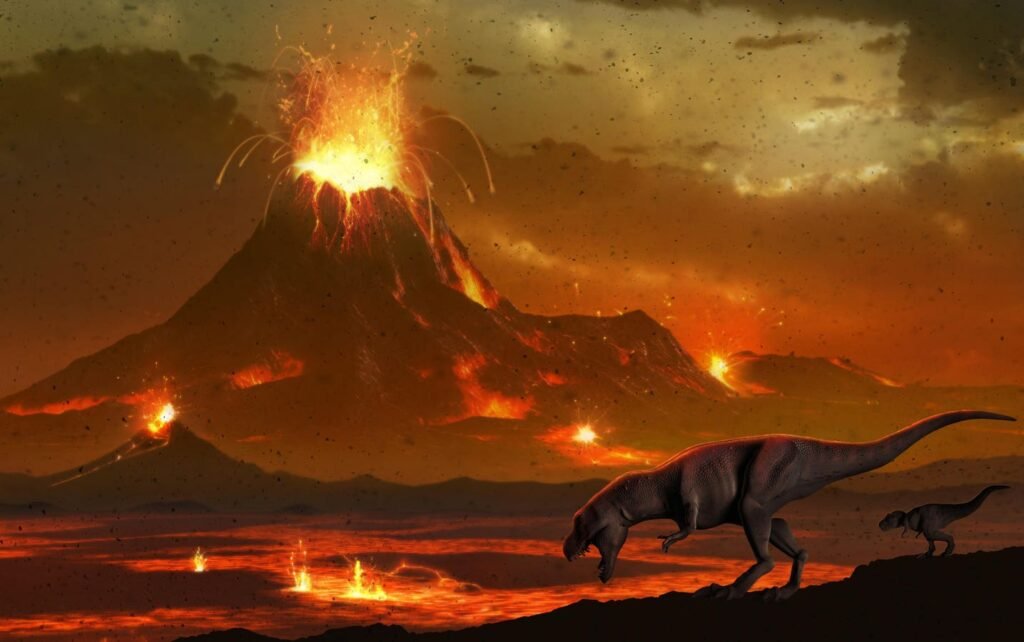Artwork of two Tyrannosaurus dinosaurs surveying a volcanic landscape.
About 66 million years ago, a meteorite struck the Earth near what is now the Yucatan Peninsula, causing widespread destruction and death. But at about the same time, intense volcanic activity covered vast areas of the Indian subcontinent with lava flows more than two kilometers thick. Scientists have long debated whether impacts, volcanic eruptions, or both were responsible for the extinction of 75% of all species living at the time, including non-avian dinosaurs.
Scientists from Utrecht University and the University of Manchester say, based on new research, that volcanic activity caused temporary climate changes, but that the effects had already disappeared thousands of years before the meteorite impact, and that most species showed that they survived this first cold snap. Scientists therefore conclude that meteorite impacts were the ultimate cause of the end-Cretaceous mass extinction event.
A meteorite impact can create a thick layer of dust and soot that blocks sunlight and cools the Earth’s surface. Volcanic eruptions release huge amounts of carbon dioxide, dust, and sulfur, thereby significantly altering the chemistry of the atmosphere and altering Earth’s climate, but in different ways and on timescales depending on meteorite impacts. Masu.
By analyzing fossil molecules in sediments deposited inside the North American continent about 65 to 66 million years ago, the scientific team reconstructed temperatures throughout that period.
The analyzed sediment contains specific molecules produced by bacteria. The structure of these molecules changes depending on the temperature of the environment in which the bacteria once lived. By analyzing the composition of these molecules in the layers of sediment deposited each year, scientists were able to reconstruct climate curves covering the periods of volcanic activity and periods of volcanic activity. Eruption and meteorite collision.
The study shows that a massive volcanic pulse occurred about 30,000 years before the impact, which coincided with a cooling of the climate by at least 5 degrees Celsius. They also conclude that this cooling is likely the result of volcanic sulfur emissions.
“These volcanic eruptions and the associated release of carbon dioxide and sulfur would have had a dramatic impact on life on Earth. However, these events occurred thousands of years before the meteorite impact and probably “It played only a small role in the extinction of the dinosaurs,” explains study author Lauren O. “Connor, geochemist at Utrecht University.
Scientists also found that by about 20,000 years before the impact, temperatures on Earth were already stable, rising to similar temperatures before volcanic eruptions began. This rapid recovery may have been helped by volcanic ejecta, which acts like a greenhouse gas, rapidly warming the planet.
A graph showing how the Earth’s average annual temperature (MAAT) has fallen during the heat wave … [+]
With the effects of volcanic activity virtually eliminated, the Yucatan meteorite impact remains the main cause of subsequent mass extinctions.
“By comparison, an asteroid impact triggered a series of disasters, including wildfires, earthquakes, tsunamis, and an ‘impact winter’ that blocked sunlight and destroyed ecosystems. We think it was an asteroid that gave it to us,” Rodri Gerrett concluded. , a geologist at the University of Manchester.
This study, “Global evidence of a volcanic sulfate-induced cooling phenomenon that occurred approximately 300,000 years before the Cretaceous-Paleogene mass extinction,” was published in the journal. scientific progress You can find it online here.
Additional materials and interviews were provided by Utrecht University.




